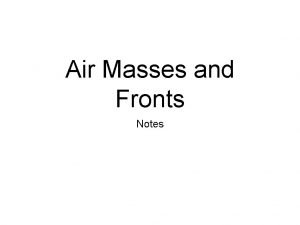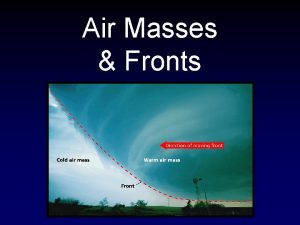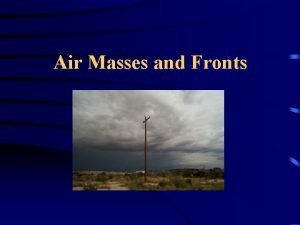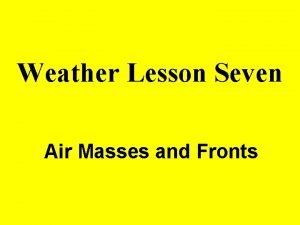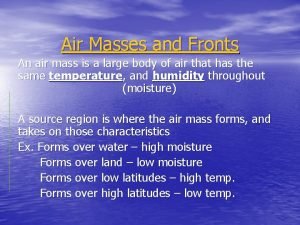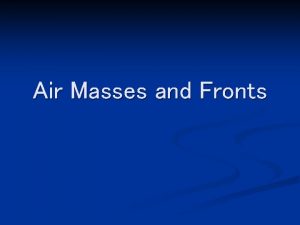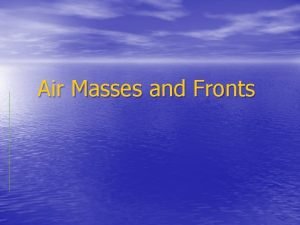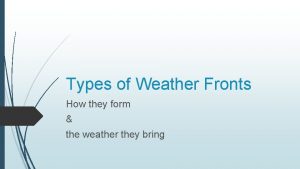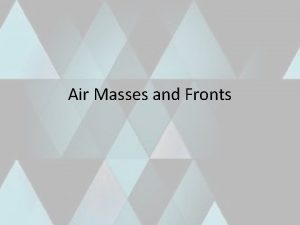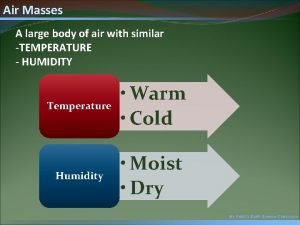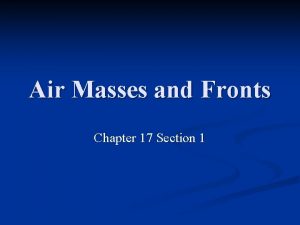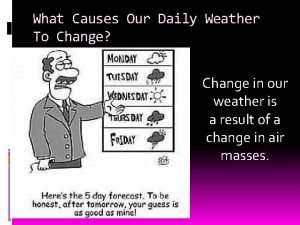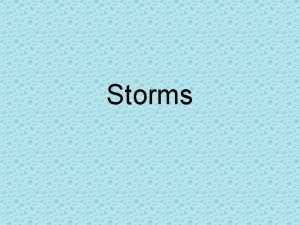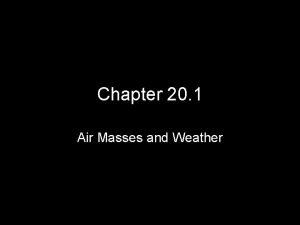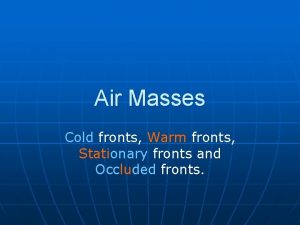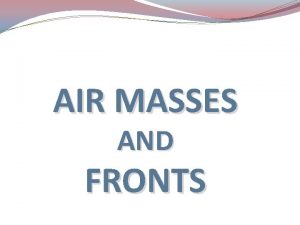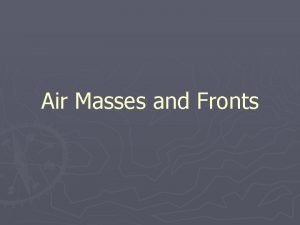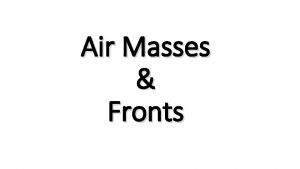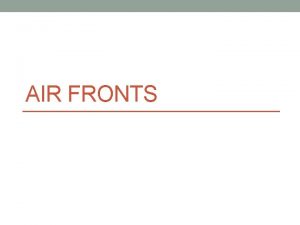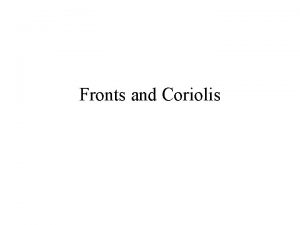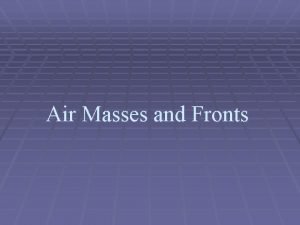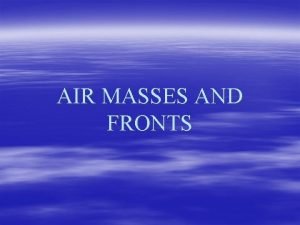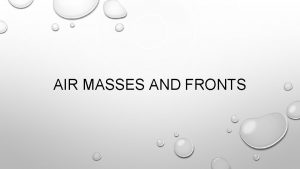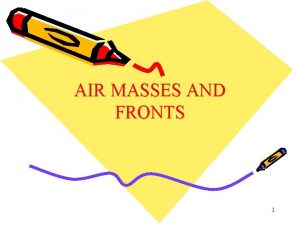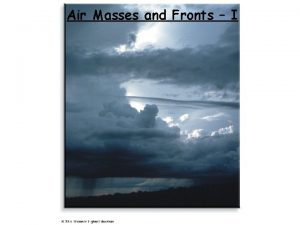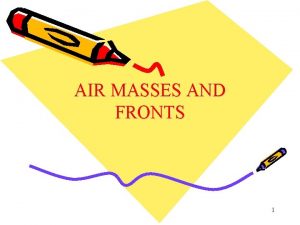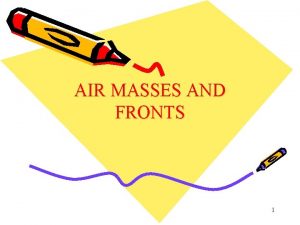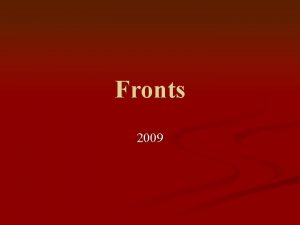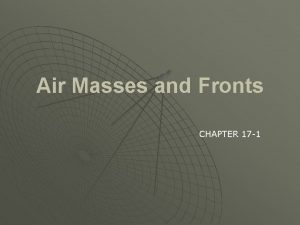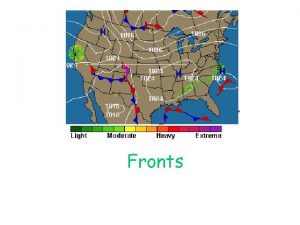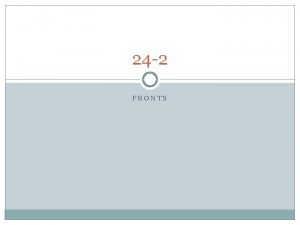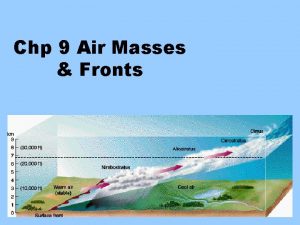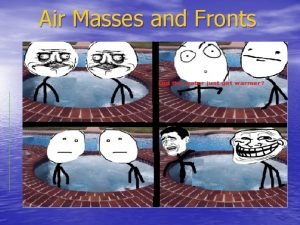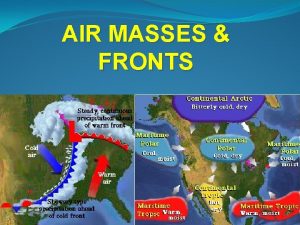AIR MASSES AND FRONTS Air Masses A large

























- Slides: 25

AIR MASSES AND FRONTS

Air Masses A large body of air with similar -TEMPERATURE - HUMIDITY Temperatur e • Warm • Cold Humidity • Moist • Dry

Air Masses’ Characteristics Source Regions Over Continental area: the warm area makes the air above warm. Over Maritime: water evaporates into the air above and makes it moist.

Air Mass Characteristics Source Regions (cont. ) Over Polar area: the frigid area makes the air above cold Over Tropical area: the warm area makes the air above warm

Types of Air Masses DESCRIPTION CONDITION LOCATION FORMED 1. Maritime: (m) moist (marina/water) 2. Continental: (c) dry (continents/land) 3. Tropical: (T) warm (tropics) 4. Polar: (P) cold (poles)

Types of Air Masses IF WE COMBINE A TEMPERATURE AND HUMIDITY CHARACTERISTIC WE CAN MAKE 4 DIFFERENT TYPES OF AIR MASSES. Maritime Tropical (m. T) Continental Tropical (m. P) Maritime Polar (m. P) Continental Polar (c. P)

Types of Air Masses c. P Continental Polar m. P Maritime Polar Dry, cold air to central and eastern US. m. P Maritime Polar Moist, cold air to east areas of the Canada Moist, cold air to west coast of the US. m. T Maritime Tropical Moist, warm air to west coast of the Mexico. c. T Continental Tropical Dry, warm to Desert SW m. T Maritime Tropical Moist, warm air to south Mr. Fetch’s Earth Science Classroom east coast of the US.

Air Mass Modification Air masses move due to the prevailing winds. The winds cause the air masses to move over land water. m. P Maritime Polar Moist, cold air to west coast of the US. As the air masses move, they change. This is called air mass modification. The air masses becomes more like the area it is moving over… …. . And At the same time, the area the air mass is moving over becomes more like the mass. Mr. Fetch’s Earth Science Classroom

What occurs when air masses collide? FRONTS and a change in weather conditions

Fronts A boundary between two air masses: COLD FRONTS WARM FRONTS STATIONARY FRONTS

When air masses meet… m. P Maritime Polar Moist, cold air to west coast of the US. m. T Maritime Tropical Moist, warm air to south Mr. Fetch’s Earth Science Classroom east coast of the US.

Cold Fronts - When cold air hits warm air. - Warm air is forced violently up. - Rising air creates clouds, rain, and storms. (FRONTAL LIFTING) Mr. Fetch’s Earth Science Classroom

Cold Fronts - When cold air hits warm air. - Warm air is forced violently up. - Rising air creates clouds, rain, and storms. (FRONTAL LIFTING)

Cold Fronts “COLD FRONT” … umm its gets colder

Warm Fronts - When warm hits cold air. - Warm air gently glides up over the cold air. - Rising air creates clouds and showers. (Less Violen Mr. Fetch’s Earth Science Classroom

Warm Fronts “WARM FRONT”… right, it gets warmer, good.

The General Pattern

Stationary Front - When a warm or cold front stops moving. - Usually several days of clouds and showers.

The high’s and low’s of weather… LOW PRESSURE: cyclones 1. Low pressure systems form along fronts. (Unstable) 2. Low pressure systems areas of rising air. (As along fronts) 3. The wind blows from HIGHS into LOWS. 4. Earth’s rotation causes the winds to rotate counter-clockwise around low pressure systems. Mr. Fetch’s Earth Science Classroom

The high’s and low’s of weather… LOW PRESSURE: 5. The rising air creates clouds and precipitation. 6. Low pressure systems created rainy, stormy weather.


The high’s and low’s of weather… HIGH PRESSURE: anticyclones 1. High pressure systems areas of sinking air. (Stable) 2. The wind blows out of HIGHS to LOWS. 3. Earth’s rotation causes the winds to rotate clockwise around high pressure systems.

The high’s and low’s of weather… HIGH PRESSURE: 4. The sinking air stops clouds from forming. 5. No clouds = Sunny, clear weather conditions.


 Mt air mass
Mt air mass Types of fronts
Types of fronts North american air masses
North american air masses Air mass source regions
Air mass source regions Two cold air masses converge on a warm air mass
Two cold air masses converge on a warm air mass Whats an air mass
Whats an air mass Air masses & frontswhat is an air mass?
Air masses & frontswhat is an air mass? What are the seven
What are the seven A swirling center of low air pressure is called
A swirling center of low air pressure is called Air masses & frontswhat is an air mass?
Air masses & frontswhat is an air mass? Air masses & frontswhat is an air mass?
Air masses & frontswhat is an air mass? Air masses & frontswhat is an air mass?
Air masses & frontswhat is an air mass? Types of fronts weather
Types of fronts weather Types of air masses
Types of air masses An air mass is a large body of air with
An air mass is a large body of air with Air masses and their characteristics
Air masses and their characteristics Area of low pressure where air masses meet and rise
Area of low pressure where air masses meet and rise Air masses form in the tropics and have low pressure
Air masses form in the tropics and have low pressure A pattern of meteorological symbols that represent weather
A pattern of meteorological symbols that represent weather Jet stream map
Jet stream map What is a cold front simple definition
What is a cold front simple definition Large scale rotating air mass
Large scale rotating air mass Importance of air masses
Importance of air masses Characteristics of air masses
Characteristics of air masses Lake effect side
Lake effect side Continental arctic air mass symbol
Continental arctic air mass symbol

